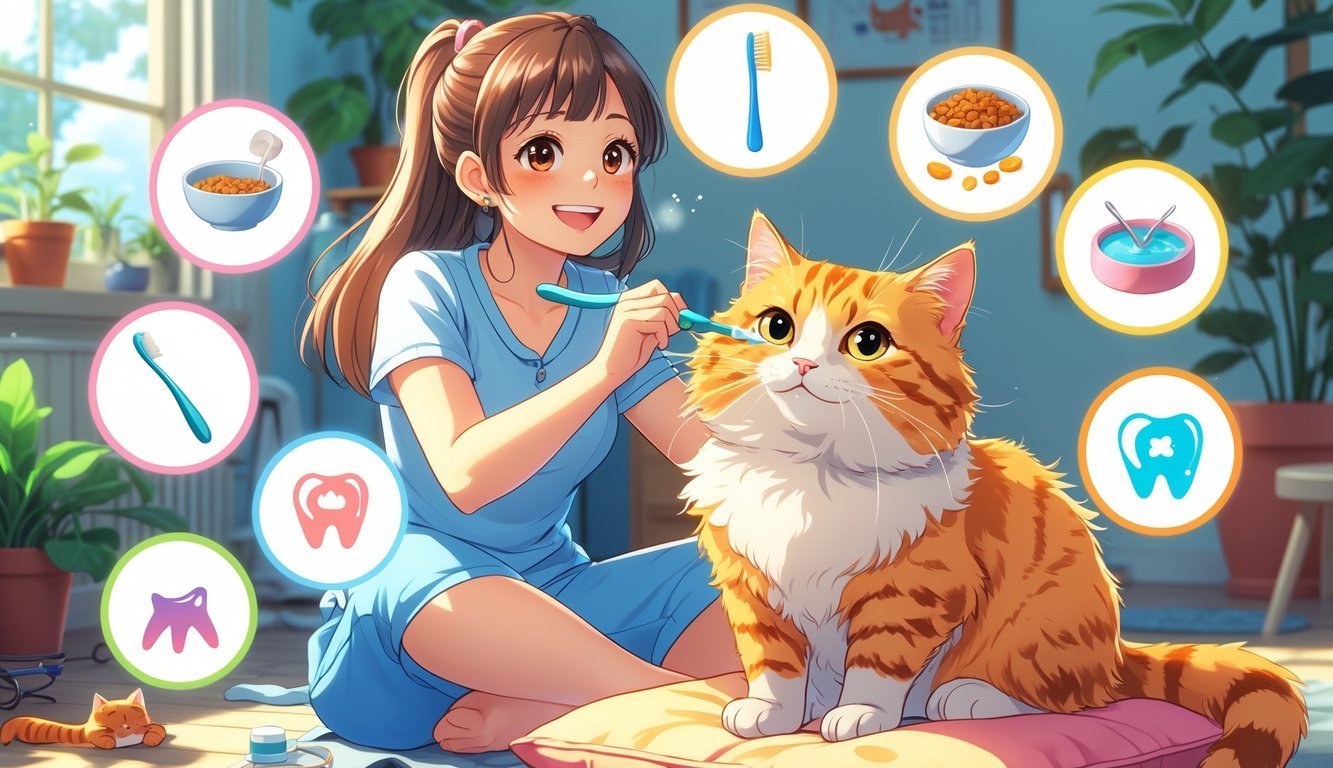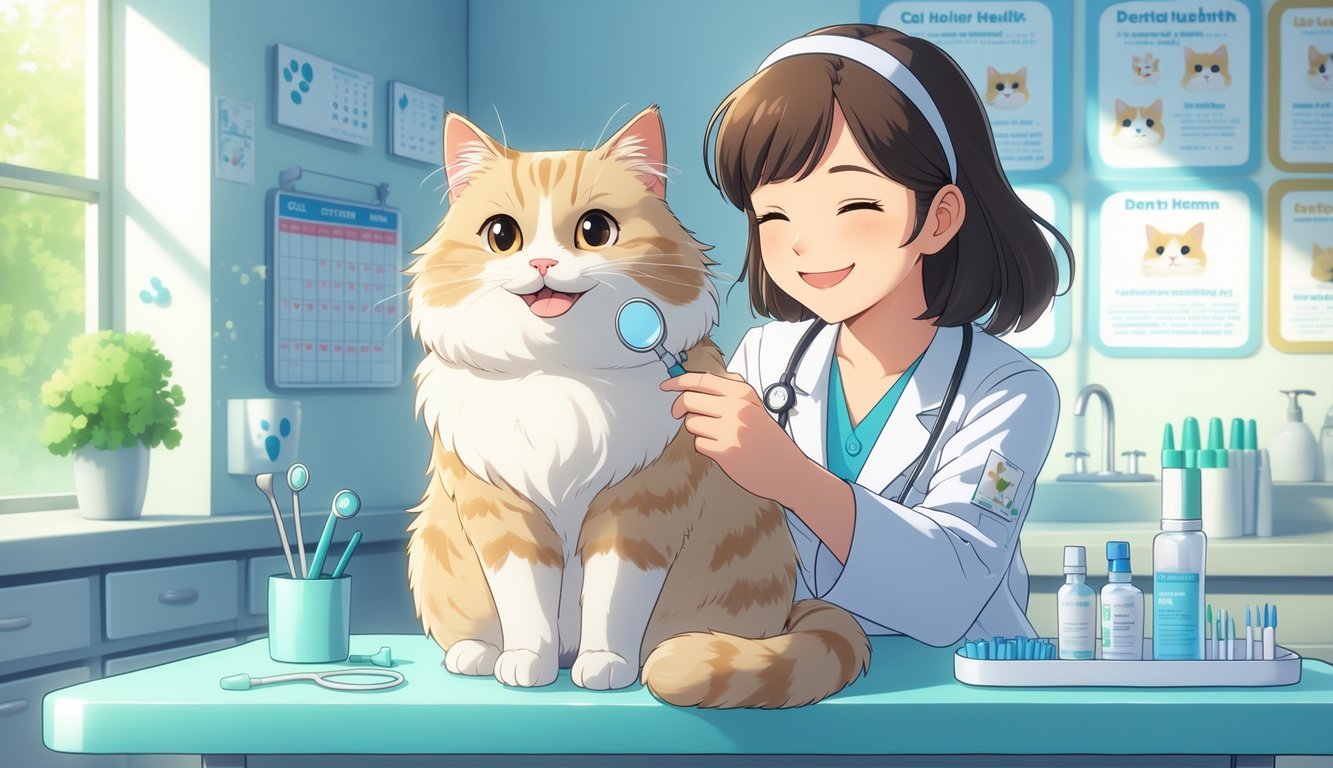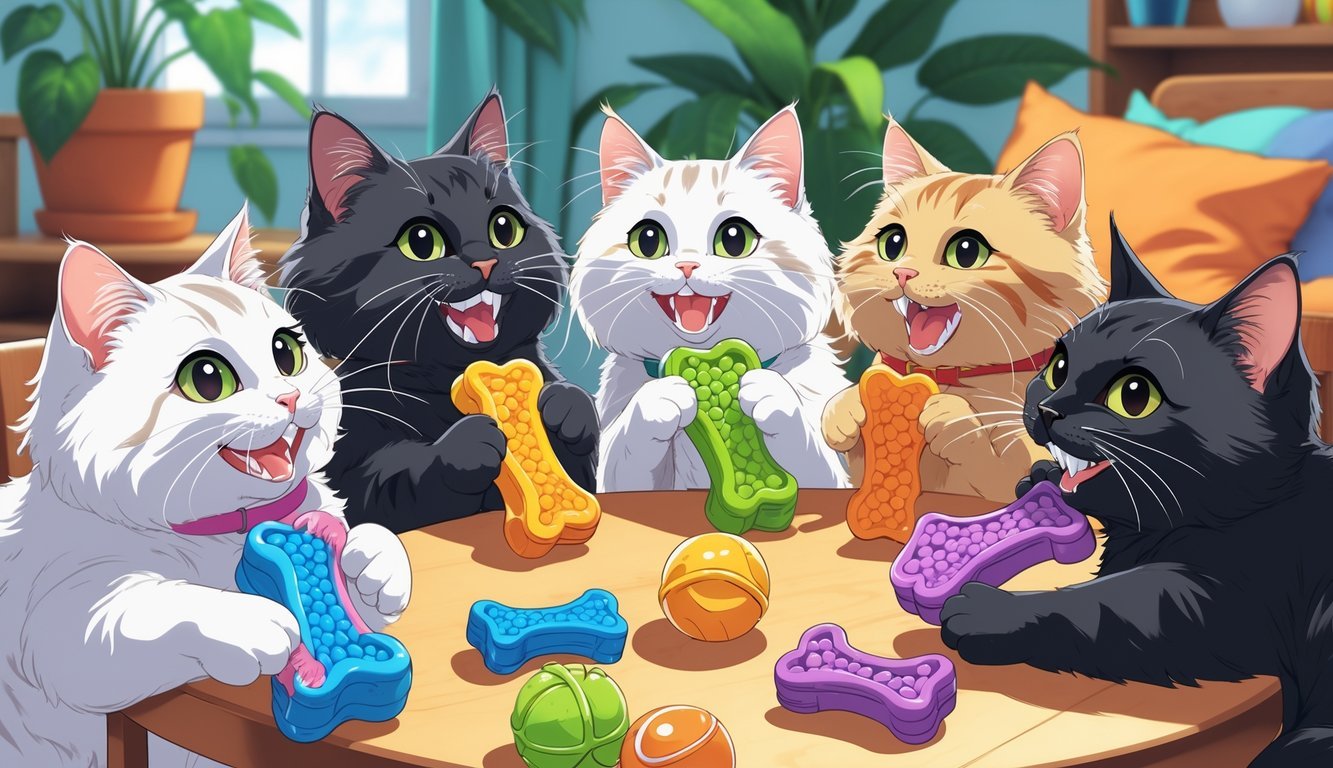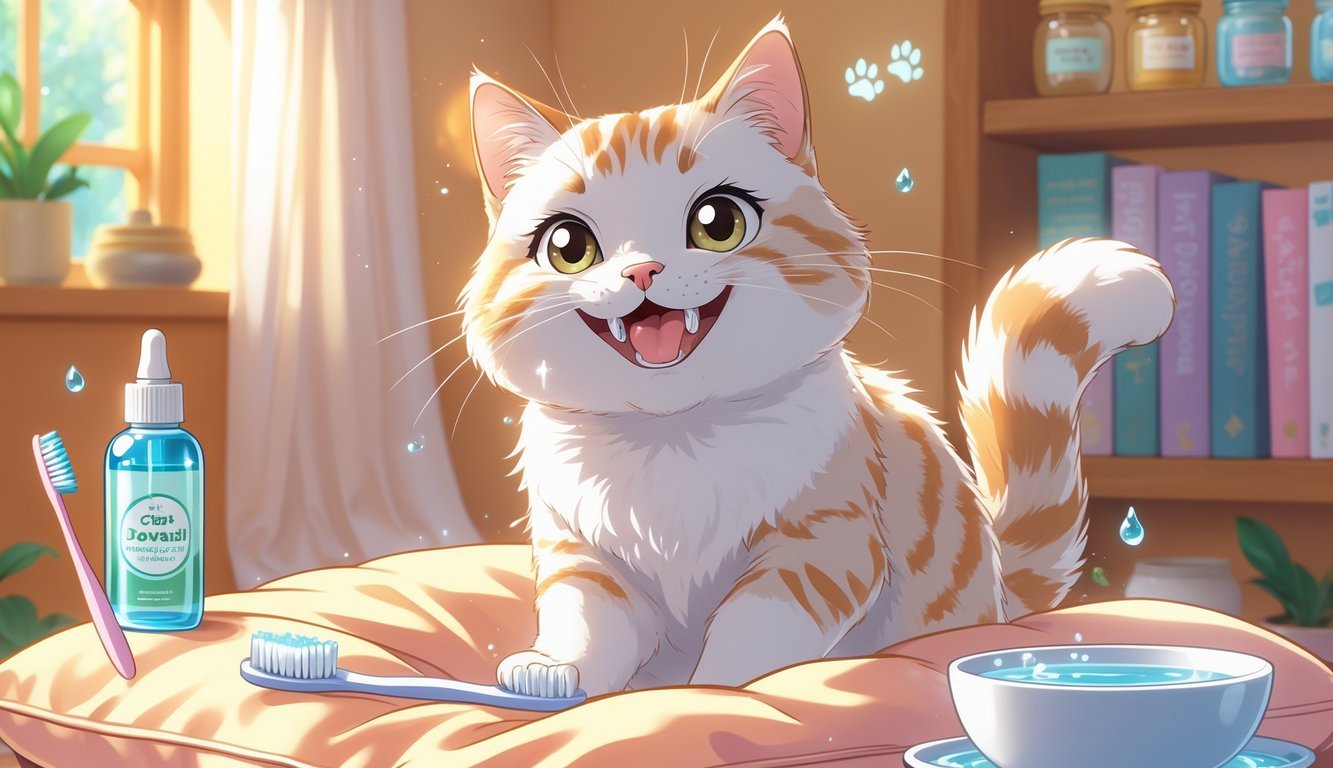PsychNewsDaily Publishers
100 Summit Drive
Burlington, MA, 01803
Telephone: (320) 349-2484
PsychNewsDaily Publishers
100 Summit Drive
Burlington, MA, 01803
Telephone: (320) 349-2484
Cat dental health significantly impacts overall well-being. Regular brushing, enzymatic toothpaste, dental treats, and vet checkups are essential for preventing dental disease and ensuring comfort.

Most cat owners get caught up in food, toys, and grooming, but let’s be honest—dental health usually gets pushed aside. It’s easy to miss how much your cat’s teeth and gums can shape their comfort, mood, and overall health. Once you get a handle on the lesser-known parts of feline dental care, you’ll start to prevent issues before they even pop up. Your cat will thank you for it.
Let’s dig into some simple, often-overlooked ways to protect your cat’s mouth. Brushing, safe toothpaste, treats, toys, and vet visits—small changes can really add up.
Pick up these practical tips and you’ll build a routine that actually supports your cat’s health long-term.

Brushing your cat’s teeth every day might be the best thing you can do for their dental health. A soft-bristled toothbrush keeps their gums safe while you clear away plaque and food bits.
Always go for toothpaste made for cats. Human toothpaste isn’t safe, and cat-friendly flavors like poultry or seafood make things go a little smoother.
If your cat’s new to brushing, don’t rush. Let them sniff the brush and try a dab of toothpaste before you even attempt to clean their teeth.
Keep those first sessions short and calm. That way, your cat gets used to it without freaking out.
Daily brushing is the gold standard, but even doing it every other day helps. Regular care at home cuts down on gum disease and keeps your cat’s mouth more comfortable.
Pick a cat toothbrush or a finger brush if your cat’s on the smaller side. The right size and softness help you reach those back teeth without hurting sensitive spots.

Brushing works best with a toothpaste made for pets. Enzymatic cat toothpaste—like Virbac—makes things easier since it’s safe for cats to swallow and comes in flavors they don’t mind.
These toothpastes use enzymes that help break down plaque and bacteria. That means less buildup, healthier gums, and usually fresher breath.
You really don’t need much—just a pea-sized dab on a soft brush or finger brush. It’s more about consistency than quantity, so keep brushing sessions short but regular.
Virbac has flavors like poultry, malt, and seafood. If you pick one your cat likes, brushing might actually become tolerable instead of a wrestling match.
Since this toothpaste doesn’t foam, you don’t have to worry if your cat swallows it. No rinsing needed, which is honestly a relief.

Dental treats can make life easier for both you and your cat. Greenies Feline Dental Treats get a lot of love because they’re crunchy and help clean teeth while your cat munches.
That crunch scrapes away some plaque and tartar. Plus, these treats have added vitamins and minerals, so you’re not just giving empty calories.
Most cats love the flavors—chicken and salmon are big hits. It’s easy to slip them into daily care as a reward or part of playtime.
Treats aren’t a substitute for brushing, but they do support oral health between cleanings. They can even help with breath, which is nice when your cat wants to snuggle.

Water additives make dental care a little more hands-off. Just pour the recommended amount into your cat’s water bowl and you’re set—no brushing needed to see some benefit.
TropiClean Fresh Breath Water Additive is made for cats and includes stuff like green tea and zinc to fight bacteria that cause bad breath. Some versions even support gum health and reduce plaque.
Daily use is simple—measure, pour, and forget about it. Most cats don’t notice anything’s changed, so you can stick with it easily.
Pair water additives with other dental care steps for the best results. Keep an eye on your cat’s teeth and gums, and don’t skip those regular vet visits.

At-home brushing helps, but your cat still needs professional cleanings. Vets can get rid of plaque and tartar that you just can’t reach, which lowers the risk of gum disease and painful dental issues.
Most cats do well with a yearly dental cleaning. If your cat has gingivitis or heavy tartar, your vet may suggest coming in more often. Vet checkups also catch little problems before they turn into bigger ones.
Cleanings happen under anesthesia so the vet can get to every tooth, even below the gumline. Anesthesia sounds scary, but it’s standard and pretty safe.
You can keep up the good work between cleanings with brushing, dental treats, or special diets. But honestly, nothing replaces a vet’s care.

If your cat’s breath suddenly stinks, don’t just shrug it off. A little odor’s normal, but a nasty, lingering smell usually means dental disease is brewing. Bad breath is often the first sign.
Drooling is another red flag. If your cat’s chin or chest is wetter than usual, their mouth might hurt, or their gums could be sore.
Watch how your cat eats. If they drop food, chew on one side, or start avoiding dry kibble, something’s up. These little changes can say a lot about dental health.
Take a peek at their gums when you can. Redness, swelling, or bleeding at mealtime means trouble. Healthy gums should look pink, not angry or inflamed.
Spotting these signs early helps you get your cat the care they need. Just keeping an eye out can make a big difference.

Regular dry food doesn’t do much for dental health, but some kibbles are actually made to help keep teeth cleaner. These special formulas use unique shapes and textures that scrub your cat’s teeth as they chew.
Brands like Hill’s Prescription Diet t/d and Royal Canin Dental Care are designed for this. They’re tested to reduce tartar and plaque while still giving your cat balanced nutrition. Usually, you’ll need a vet’s okay to buy them.
Switching to dental kibble is an easy way to add some extra oral care, especially if your cat hates brushing. It won’t replace brushing, but it helps slow down plaque and keeps gums healthier.
If you try dental kibble, introduce it slowly so your cat doesn’t get an upset tummy. Some cats like it mixed with their regular food at first. Always keep fresh water out, since dry food isn’t enough for hydration.

Don’t use your own toothpaste on your cat—it’s just not safe. Human toothpaste has fluoride and sometimes xylitol, which are both toxic to cats. Even a little can make your cat sick or hurt their organs.
Stick to toothpaste made for pets every time you brush. Cat-safe formulas are meant to be swallowed, and they come in flavors cats actually like. That makes brushing go a lot smoother.
Keep human toothpaste out of reach, too. Cats are nosy and might chew on a tube if they find it, so stash it in a cabinet or drawer.
Using the right stuff keeps your cat healthy and makes dental care a lot less stressful. It’s a simple swap that really matters.

If your cat won’t let you near their mouth with a brush, dental wipes can be a lifesaver. These wipes gently clean teeth and gums without the drama of a toothbrush.
Just wrap a wipe around your finger and rub it along your cat’s teeth. It’ll remove some plaque and help freshen their breath. It’s quick and usually less stressful for both of you.
Dental wipes can’t fully replace brushing, but they’re better than nothing. Using them a few times a week can still help.
Choose wipes made for cats and check the ingredients to avoid anything harmful. Some even have flavors that make things easier, since your cat might actually tolerate them.
This trick works especially well for cats with tiny mouths or those who panic during brushing. It’s a way to care for their teeth without turning it into a daily battle.

Chew toys aren’t just fun—they actually help with dental care. When your cat chews, the textured surfaces scrape away soft plaque and keep gums stimulated. It’s a simple way to support cleaner teeth without stressing anyone out.
You’ll find all kinds of dental toys, from rubber chews to catnip-filled ones. Some use mesh or rope that gently rubs teeth during play. Pick a toy that matches your cat’s play style to keep them interested.
Chew toys don’t replace brushing, but they do add support. Plus, they encourage natural chewing and help with boredom or redirect chewing from your furniture.
Always check that toys are durable enough for your cat. Some cats play rough, so you want something that lasts and stays safe. Swap out toys now and then to keep things fresh and effective.
Chew toys give your cat a fun, easy way to help their teeth stay clean. It’s a no-brainer step that fits right into daily play.

If your cat has dental problems and you don’t treat them, the trouble doesn’t just stay in their mouth. Bacteria from gum disease or infected teeth can actually slip into the bloodstream and travel throughout the body.
This puts extra pressure on organs like the heart, liver, and kidneys. Over time, those organs might not work as well, and your cat’s overall health can start to slide.
You might see changes like lower energy, weight loss, or maybe your cat just isn’t eating like usual. Strangely enough, these signs don’t always scream “mouth problem,” but dental disease can quietly be the reason.
Keeping up with dental checkups and caring for your cat’s teeth at home really does lower the risk of bigger health problems. It’s more than just fighting bad breath—it’s about helping your cat stay healthy from head to tail.

Before you grab a toothbrush or start using dental products, talk to your vet first. Your cat could already have gum disease, tooth damage, or something else going on that needs a pro’s touch.
A vet will check your cat’s mouth and tell you if it’s actually safe to start brushing. If there’s pain, loose teeth, or infection, brushing at home could just make things worse.
Your vet can also suggest the best products for your cat. Let’s be honest—not every toothpaste, chew, or additive is safe or even useful. You don’t want to waste money or accidentally use something harmful.
Regular check-ups let you keep an eye on your cat’s dental health as the years go by. That way, you can spot changes early and tweak your routine if you need to.
When you talk with your vet first, you set yourself up for a safer and smarter dental care plan.

Your cat’s teeth and gums can run into problems that go way beyond their mouth. Things like plaque, tartar, and gum disease cause pain, infection, and can even start messing with organs if you don’t catch them early.
Cats get plaque and tartar buildup pretty often. Plaque is this soft film of bacteria that, if you don’t remove it, hardens into tartar. Tartar then irritates the gums and brings on gingivitis.
Another big issue is periodontal disease. That’s when the stuff that holds the teeth in place starts to break down. It can lead to tooth loss, bleeding gums, and ongoing pain.
You should also watch out for tooth resorption. Basically, the cat’s body starts breaking down the tooth itself. It’s surprisingly common and usually goes unnoticed until your cat acts like eating hurts.
Other dental problems include stomatitis (that’s inflammation of the mouth lining) and broken teeth—usually from accidents or chewing on something too hard. Regular dental checks help you catch these things before they get out of hand.
Bad dental health doesn’t just hang out in the mouth. Bacteria from infected gums can get into the bloodstream and start affecting major organs like the heart, kidneys, and liver. That can lead to bigger, long-term health problems.
Dental pain also changes how your cat eats. You might notice weight loss, dropping food, or your cat steering clear of dry kibble. Without proper nutrition, your cat’s immune system can take a hit.
Cats are pretty good at hiding pain, so you might not notice anything’s wrong until the disease is advanced. That’s why regular cleanings and checkups matter—they keep your cat’s whole body healthier, not just their teeth.

Good dental care for your cat really comes down to the products you use and how you introduce them. Simple daily habits and the right tools make a big difference for your cat’s teeth and gums.
Start with a cat-specific toothbrush or a soft finger brush. Human toothbrushes are usually too big and can hurt your cat’s mouth. Go for small heads and soft bristles.
Always pick pet-safe toothpaste. Human toothpaste has fluoride and xylitol, which are toxic for cats. Pet toothpaste comes in flavors like poultry or fish, so your cat might actually like it.
Dental treats and chews can help cut down plaque if brushing isn’t going to happen. Look for products approved by the Veterinary Oral Health Council (VOHC). Those have been tested and shown to slow tartar buildup.
You can also try water additives or dental powders. They’re not a substitute for brushing, but they can help if you use them regularly.
Not every product will work for every cat. Pay attention to what your cat tolerates and stick with safe, vet-approved options.
Go slow when you introduce dental care. Let your cat sniff or lick the toothbrush or toothpaste without actually brushing.
This simple step helps your cat get used to the process. It can ease their nerves a bit.
When your cat seems calm, use your finger to gently rub along their gums for just a few seconds. Later, swap your finger for the toothbrush.
Keep these sessions super short at first. Just a few seconds is enough. Always follow up with a treat—cats love a little reward.
Patience really matters. Some cats need weeks to get used to all this. If your cat pushes back or seems stressed, don’t force it.
Try dental chews or water additives as alternatives until your cat feels more at ease.
You don’t have to be perfect—just consistent. Brushing a few times a week, along with other dental products, can really help your cat’s teeth stay healthier.